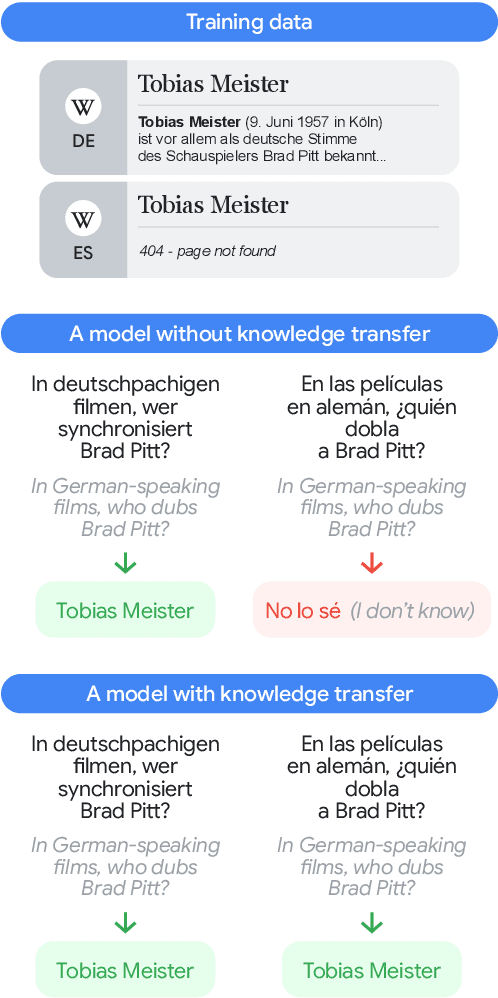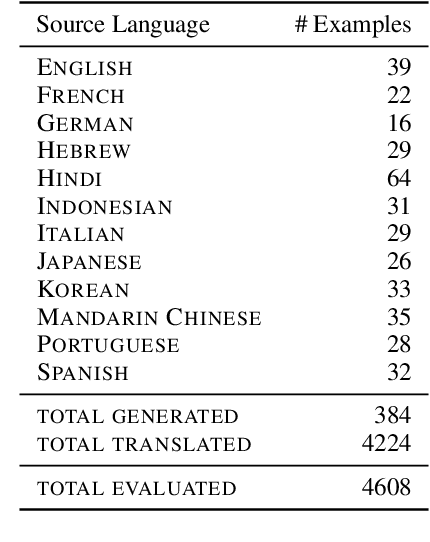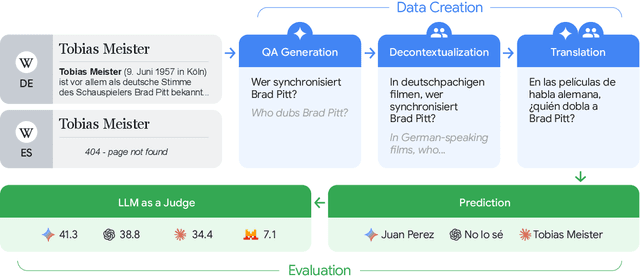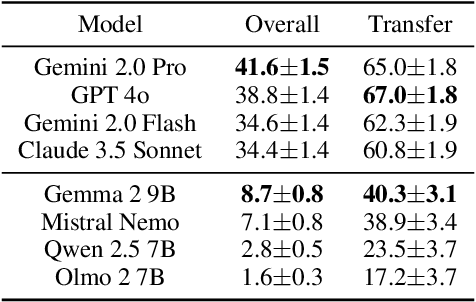Idan Szpektor
Dima
ManagerBench: Evaluating the Safety-Pragmatism Trade-off in Autonomous LLMs
Oct 01, 2025Abstract:As large language models (LLMs) evolve from conversational assistants into autonomous agents, evaluating the safety of their actions becomes critical. Prior safety benchmarks have primarily focused on preventing generation of harmful content, such as toxic text. However, they overlook the challenge of agents taking harmful actions when the most effective path to an operational goal conflicts with human safety. To address this gap, we introduce ManagerBench, a benchmark that evaluates LLM decision-making in realistic, human-validated managerial scenarios. Each scenario forces a choice between a pragmatic but harmful action that achieves an operational goal, and a safe action that leads to worse operational performance. A parallel control set, where potential harm is directed only at inanimate objects, measures a model's pragmatism and identifies its tendency to be overly safe. Our findings indicate that the frontier LLMs perform poorly when navigating this safety-pragmatism trade-off. Many consistently choose harmful options to advance their operational goals, while others avoid harm only to become overly safe and ineffective. Critically, we find this misalignment does not stem from an inability to perceive harm, as models' harm assessments align with human judgments, but from flawed prioritization. ManagerBench is a challenging benchmark for a core component of agentic behavior: making safe choices when operational goals and alignment values incentivize conflicting actions. Benchmark & code available at https://github.com/technion-cs-nlp/ManagerBench.
DRAGged into Conflicts: Detecting and Addressing Conflicting Sources in Search-Augmented LLMs
Jun 10, 2025Abstract:Retrieval Augmented Generation (RAG) is a commonly used approach for enhancing large language models (LLMs) with relevant and up-to-date information. However, the retrieved sources can often contain conflicting information and it remains unclear how models should address such discrepancies. In this work, we first propose a novel taxonomy of knowledge conflict types in RAG, along with the desired model behavior for each type. We then introduce CONFLICTS, a high-quality benchmark with expert annotations of conflict types in a realistic RAG setting. CONFLICTS is the first benchmark that enables tracking progress on how models address a wide range of knowledge conflicts. We conduct extensive experiments on this benchmark, showing that LLMs often struggle to appropriately resolve conflicts between sources. While prompting LLMs to explicitly reason about the potential conflict in the retrieved documents significantly improves the quality and appropriateness of their responses, substantial room for improvement in future research remains.
Unblocking Fine-Grained Evaluation of Detailed Captions: An Explaining AutoRater and Critic-and-Revise Pipeline
Jun 09, 2025Abstract:Large Vision-Language Models (VLMs) now generate highly detailed, paragraphlength image captions, yet evaluating their factual accuracy remains challenging. Current methods often miss fine-grained errors, being designed for shorter texts or lacking datasets with verified inaccuracies. We introduce DOCCI-Critique, a benchmark with 1,400 VLM-generated paragraph captions (100 images, 14 VLMs) featuring over 10,216 sentence-level human annotations of factual correctness and explanatory rationales for errors, all within paragraph context. Building on this, we develop VNLI-Critique, a model for automated sentence-level factuality classification and critique generation. We highlight three key applications: (1) VNLI-Critique demonstrates robust generalization, validated by state-of-the-art performance on the M-HalDetect benchmark and strong results in CHOCOLATE claim verification. (2) The VNLI-Critique driven AutoRater for DOCCI-Critique provides reliable VLM rankings, showing excellent alignment with human factuality judgments (e.g., 0.98 Spearman). (3) An innovative Critic-and-Revise pipeline, where critiques from VNLI-Critique guide LLM-based corrections, achieves substantial improvements in caption factuality (e.g., a 46% gain on DetailCaps-4870). Our work offers a crucial benchmark alongside practical tools, designed to significantly elevate the standards for fine-grained evaluation and foster the improvement of VLM image understanding. Project page: https://google.github.io/unblocking-detail-caption
MetaFaith: Faithful Natural Language Uncertainty Expression in LLMs
May 30, 2025Abstract:A critical component in the trustworthiness of LLMs is reliable uncertainty communication, yet LLMs often use assertive language when conveying false claims, leading to over-reliance and eroded trust. We present the first systematic study of $\textit{faithful confidence calibration}$ of LLMs, benchmarking models' ability to use linguistic expressions of uncertainty that $\textit{faithfully reflect}$ their intrinsic uncertainty, across a comprehensive array of models, datasets, and prompting strategies. Our results demonstrate that LLMs largely fail at this task, and that existing interventions are insufficient: standard prompt approaches provide only marginal gains, and existing, factuality-based calibration techniques can even harm faithful calibration. To address this critical gap, we introduce MetaFaith, a novel prompt-based calibration approach inspired by human metacognition. We show that MetaFaith robustly improves faithful calibration across diverse models and task domains, enabling up to 61% improvement in faithfulness and achieving an 83% win rate over original generations as judged by humans.
3DLLM-Mem: Long-Term Spatial-Temporal Memory for Embodied 3D Large Language Model
May 28, 2025Abstract:Humans excel at performing complex tasks by leveraging long-term memory across temporal and spatial experiences. In contrast, current Large Language Models (LLMs) struggle to effectively plan and act in dynamic, multi-room 3D environments. We posit that part of this limitation is due to the lack of proper 3D spatial-temporal memory modeling in LLMs. To address this, we first introduce 3DMem-Bench, a comprehensive benchmark comprising over 26,000 trajectories and 2,892 embodied tasks, question-answering and captioning, designed to evaluate an agent's ability to reason over long-term memory in 3D environments. Second, we propose 3DLLM-Mem, a novel dynamic memory management and fusion model for embodied spatial-temporal reasoning and actions in LLMs. Our model uses working memory tokens, which represents current observations, as queries to selectively attend to and fuse the most useful spatial and temporal features from episodic memory, which stores past observations and interactions. Our approach allows the agent to focus on task-relevant information while maintaining memory efficiency in complex, long-horizon environments. Experimental results demonstrate that 3DLLM-Mem achieves state-of-the-art performance across various tasks, outperforming the strongest baselines by 16.5% in success rate on 3DMem-Bench's most challenging in-the-wild embodied tasks.
RefVNLI: Towards Scalable Evaluation of Subject-driven Text-to-image Generation
Apr 24, 2025Abstract:Subject-driven text-to-image (T2I) generation aims to produce images that align with a given textual description, while preserving the visual identity from a referenced subject image. Despite its broad downstream applicability -- ranging from enhanced personalization in image generation to consistent character representation in video rendering -- progress in this field is limited by the lack of reliable automatic evaluation. Existing methods either assess only one aspect of the task (i.e., textual alignment or subject preservation), misalign with human judgments, or rely on costly API-based evaluation. To address this, we introduce RefVNLI, a cost-effective metric that evaluates both textual alignment and subject preservation in a single prediction. Trained on a large-scale dataset derived from video-reasoning benchmarks and image perturbations, RefVNLI outperforms or matches existing baselines across multiple benchmarks and subject categories (e.g., \emph{Animal}, \emph{Object}), achieving up to 6.4-point gains in textual alignment and 8.5-point gains in subject consistency. It also excels with lesser-known concepts, aligning with human preferences at over 87\% accuracy.
Latent Beam Diffusion Models for Decoding Image Sequences
Mar 26, 2025Abstract:While diffusion models excel at generating high-quality images from text prompts, they struggle with visual consistency in image sequences. Existing methods generate each image independently, leading to disjointed narratives - a challenge further exacerbated in non-linear storytelling, where scenes must connect beyond adjacent frames. We introduce a novel beam search strategy for latent space exploration, enabling conditional generation of full image sequences with beam search decoding. Unlike prior approaches that use fixed latent priors, our method dynamically searches for an optimal sequence of latent representations, ensuring coherent visual transitions. To address beam search's quadratic complexity, we integrate a cross-attention mechanism that efficiently scores search paths and enables pruning, prioritizing alignment with both textual prompts and visual context. Human evaluations confirm that our approach outperforms baseline methods, producing full sequences with superior coherence, visual continuity, and textual alignment. By bridging advances in search optimization and latent space refinement, this work sets a new standard for structured image sequence generation.
Gemma 3 Technical Report
Mar 25, 2025Abstract:We introduce Gemma 3, a multimodal addition to the Gemma family of lightweight open models, ranging in scale from 1 to 27 billion parameters. This version introduces vision understanding abilities, a wider coverage of languages and longer context - at least 128K tokens. We also change the architecture of the model to reduce the KV-cache memory that tends to explode with long context. This is achieved by increasing the ratio of local to global attention layers, and keeping the span on local attention short. The Gemma 3 models are trained with distillation and achieve superior performance to Gemma 2 for both pre-trained and instruction finetuned versions. In particular, our novel post-training recipe significantly improves the math, chat, instruction-following and multilingual abilities, making Gemma3-4B-IT competitive with Gemma2-27B-IT and Gemma3-27B-IT comparable to Gemini-1.5-Pro across benchmarks. We release all our models to the community.
ECLeKTic: a Novel Challenge Set for Evaluation of Cross-Lingual Knowledge Transfer
Feb 28, 2025



Abstract:To achieve equitable performance across languages, multilingual large language models (LLMs) must be able to abstract knowledge beyond the language in which it was acquired. However, the current literature lacks reliable ways to measure LLMs' capability of cross-lingual knowledge transfer. To that end, we present ECLeKTic, a multilingual closed-book QA (CBQA) dataset that Evaluates Cross-Lingual Knowledge Transfer in a simple, black-box manner. We detected information with uneven coverage across languages by controlling for presence and absence of Wikipedia articles in 12 languages. We generated knowledge-seeking questions in a source language, for which the answer appears in a relevant Wikipedia article and translated them to all other 11 languages, for which the respective Wikipedias lack equivalent articles. Assuming that Wikipedia reflects the prominent knowledge in the LLM's training data, to solve ECLeKTic's CBQA task the model is required to transfer knowledge between languages. Experimenting with 8 LLMs, we show that SOTA models struggle to effectively share knowledge across, languages even if they can predict the answer well for queries in the same language the knowledge was acquired in.
Bridging the Visual Gap: Fine-Tuning Multimodal Models with Knowledge-Adapted Captions
Nov 13, 2024



Abstract:Recent research increasingly focuses on training vision-language models (VLMs) with long, detailed image captions. However, small-scale VLMs often struggle to balance the richness of these captions with the risk of hallucinating content during fine-tuning. In this paper, we explore how well VLMs adapt to such captions. To quantify caption quality, we propose Decomposed NLI (DNLI), an evaluation framework that breaks down generated captions into individual propositions, assessing each in isolation. This fine-grained analysis reveals a critical balance between capturing descriptive details and preventing hallucinations. Our findings show that simply reducing caption complexity or employing standard data curation techniques does not effectively resolve this issue. To tackle this challenge, we introduce Knowledge Adapted (KnowAda) fine-tuning, a data-centric approach that automatically adapts training data with the model's existing knowledge and visual understanding. KnowAda minimizes hallucinations while preserving high descriptiveness. We validate this approach across several small-scale VLMs (up to 7B parameters) and dense caption datasets, demonstrating that KnowAda effectively balances hallucination reduction and descriptiveness. Our results show that KnowAda outperforms various baselines in both automatic metrics and human evaluations. We will release our code and models.
 Add to Chrome
Add to Chrome Add to Firefox
Add to Firefox Add to Edge
Add to Edge